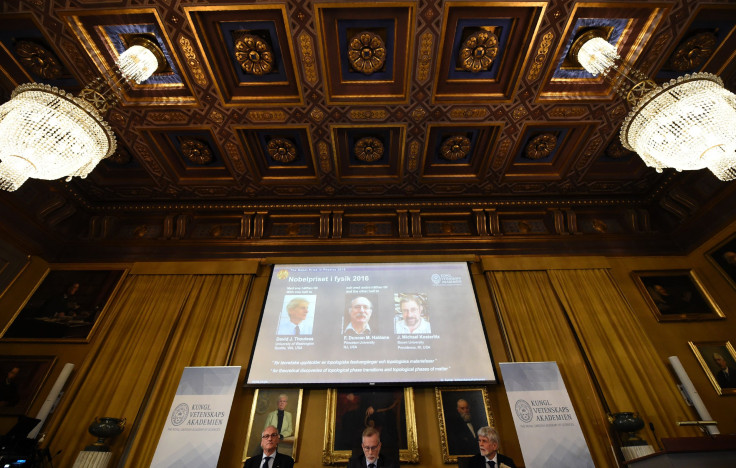Nobel Prize In Physics 2016: David Thouless, Duncan Haldane And Michael Kosterlitz Awarded For Work On Exotic States Of Matter

The 2016 Nobel Prize in physics was awarded Tuesday to David Thouless from the University of Washington, Duncan Haldane from Princeton University and J. Michael Kosterlitz from Brown University for their work related to the study of exotic matter. The three physicists, all of them born in the United Kingdom, came up with the mathematical framework to explain properties of unusual phases of matter such as superconductors, superfluids and thin magnetic films.
BREAKING NEWS #NobelPrize in Physics 2016 to David Thouless, Duncan Haldane and Michael Kosterlitz pic.twitter.com/5jw75GIjRv
— The Nobel Prize (@NobelPrize) October 4, 2016
The laureates will share a prize amount of 8 million Swedish kronor ($936,000), one half of which will go to Thouless, while the other half will be shared between Haldane and Kosterlitz.
“In the early 1970s, Michael Kosterlitz and David Thouless overturned the then current theory that superconductivity or suprafluidity could not occur in thin layers. They demonstrated that superconductivity could occur at low temperatures and also explained the mechanism, phase transition, that makes superconductivity disappear at higher temperatures,” the Royal Swedish Academy of Sciences, which awards the physics Nobel, explained in a statement. “In the 1980s, Thouless was able to explain a previous experiment with very thin electrically conducting layers in which conductance was precisely measured as integer steps.”
Haldane, meanwhile, discovered how concepts of topology — which refers to the study of properties that only change stepwise — can be used to understand the properties of chains of small magnets found in some materials.
The most common phases of matter are gas, liquid & solid. In extremely high or low temperatures matter assumes more exotic states pic.twitter.com/ZpwAuDfeYT
— The Nobel Prize (@NobelPrize) October 4, 2016
Their discoveries helped scientists design new materials. “Over the last decade, this area has boosted frontline research in condensed matter physics, not least because of the hope that topological materials could be used in new generations of electronics and superconductors, or in future quantum computers,” the academy said.
Member of the Nobel committee for physics explains topology using a cinnamon bun, a bagel and a pretzel https://t.co/gORO04UYam
— The Nobel Prize (@NobelPrize) October 4, 2016
The Nobel Prize in physics has been awarded 110 times to 204 laureates since 1901.
Last year, the physics prize went to Japan’s Takaaki Kajita and Canada’s Arthur B. McDonald for experiments that demonstrated neutrino oscillations. The discovery that neutrinos — perhaps the most abundant particles, but the least understood, in the universe, can oscillate — or change “flavors” — revealed that these particles must have some mass, however small.
© Copyright IBTimes 2024. All rights reserved.






















